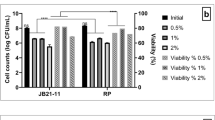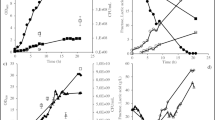Abstract
Lactic acid bacteria (LAB) play an important role as natural preservatives in fermented food and beverage systems, reducing the application of chemical additives. Thus, investigating their antifungal compounds, such as cyclic dipeptides, has gained prominence. Previous research has primarily focussed on isolation of these compounds. However, their precise quantification will provide further information regarding their antifungal performance in a complex system. To address this, deuterated labelled standards of the cyclic dipeptides cyclo(Leu-Pro), cyclo(Pro-Pro), cyclo(Met-Pro) and cyclo(Phe-Pro) were synthesized, and stable isotope dilution assays were developed, enabling an accurate quantification of cyclo(Leu-Pro), cyclo(Pro-Pro), cyclo(Met-Pro) and cyclo(Phe-Pro) in MRS-broth and wort. Quantitative results showed that, in the Lactobacillus brevis R2Δ fermented MRS-broth, the concentrations of cyclo(Leu-Pro), cyclo(Pro-Pro) and cyclo(Phe-Pro) were significantly higher (P < 0.05), than in wort for cyclo (Leu-Pro) when compared with their controls. This indicates that the formation of these three cyclic dipeptides is related to L. brevis R2Δ metabolism. Furthermore, this represents the first report of cyclic dipeptides quantification using stable isotope dilution assays in LAB cultures both in vitro and in a food system.





Similar content being viewed by others
References
Borthwick AD (2012) 2,5-Diketopiperazines: synthesis, reactions, medicinal chemistry, and bioactive natural products. Chem Rev 112(7):3641–3716. doi:10.1021/cr200398y
Cornacchia C, Cacciatore I, Baldassarre L, Mollica A, Feliciani F, Pinnen F (2012) 2,5-Diketopiperazines as neuroprotective agents. Mini-Rev Med Chem 12(1):2–12
de Carvalho MP, Abraham WR (2012) Antimicrobial and biofilm inhibiting diketopiperazines. Curr Med Chem 19(21):3564–3577
Huang RM, Zhou XF, Xu TH, Yang XW, Liu YH (2010) Diketopiperazines from marine organisms. Chem Biodivers 7(12):2809–2829. doi:10.1002/cbdv.200900211
Ressurreicao ASM, Delatouche R, Gennari C, Piarulli U (2011) Bifunctional 2,5-diketopiperazines as rigid three-dimensional scaffolds in receptors and peptidomimetics. Eur J Org Chem 2:217–228. doi:10.1002/ejoc.201001330
Prasad C (1995) Bioactive cyclic dipeptides. Peptides 16(1):151–164. doi:10.1016/0196-9781(94)00017-z
Martins MB, Carvalho I (2007) Diketopiperazines: biological activity and synthesis. Tetrahedron 63(40):9923–9932. doi:10.1016/j.tet.2007.04.105
O’Neill JC, Lin Q, Geske GD, Carlson B, Blackwell HE (2007) Evaluation of 2,5-diketopiperazines as quorum sensing modulators. Abstr Pap Am Chem Soc 233
Wang J-H, Quan C-S, Qi X-H, Li X, Fan S-D (2010) Determination of diketopiperazines of Burkholderia cepacia CF-66 by gas chromatography–mass spectrometry. Anal Bioanal Chem 396(5):1773–1779. doi:10.1007/s00216-009-3379-3
Ryan LAM, Zannini E, Dal Bello F, Pawlowska A, Koehler P, Arendt EK (2011) Lactobacillus amylovorus DSM 19280 as a novel food-grade antifungal agent for bakery products. Int J Food Microbiol 146(3):276–283. doi:10.1016/j.ijfoodmicro.2011.02.036
Dal Bello F, Clarke CI, Ryan LAM, Ulmer H, Schober TJ, Strom K, Sjogren J, van Sinderen D, Schnurer J, Arendt EK (2007) Improvement of the quality and shelf life of wheat bread by fermentation with the antifungal strain Lactobacillus plantarum FST 1.7. J Cereal Sci 45(3):309–318. doi:10.1016/j.jcs.2006.09.004
Li J, Wang W, Xu SX, Magarvey NA, McCormick JK (2011) Lactobacillus reuteri-produced cyclic dipeptides quench agr-mediated expression of toxic shock syndrome toxin-1 in staphylococci. Proc Natl Acad Sci U S A 108(8):3360–3365. doi:10.1073/pnas.1017431108
Magnusson J, Strom K, Roos S, Sjogren J, Schnurer J (2003) Broad and complex antifungal activity among environmental isolates of lactic acid bacteria. FEMS Microbiol Lett 219(1):129–135. doi:10.1016/s0378-1097(02)01207-7
Niku-Paavola ML, Laitila A, Mattila-Sandholm T, Haikara A (1999) New types of antimicrobial compounds produced by Lactobacillus plantarum. J Appl Microbiol 86(1):29–35. doi:10.1046/j.1365-2672.1999.00632.x
Strom K, Sjogren J, Broberg A, Schnurer J (2002) Lactobacillus plantarum MiLAB 393 produces the antifungal cyclic dipeptides cyclo(L-Phe-L-Pro) and cyclo(L-Phe-trans-4-OH-L-Pro) and 3-phenyllactic acid. Appl Environ Microbiol 68(9):4322–4327. doi:10.1128/aem.68.9.4322-4327.2002
Yang EJ, Chang HC (2010) Purification of a new antifungal compound produced by Lactobacillus plantarum AF1 isolated from kimchi. Int J Food Microbiol 139(1–2):56–63. doi:10.1016/j.ijfoodmicro.2010.02.012
Opinion of the Scientific Committee on a request from EFSA on the introduction of a Qualified Presumption of Safety (QPS) approach for assessment of selected microorganisms referred to EFSA. (2007). The EFSA Journal 587:1–16
Pawlowska AM, Zannini E, Coffey A, Arendt EK (2012) “Green preservatives”: combating fungi in the food and feed industry by applying antifungal lactic acid bacteria. Adv Food Nutr Res 66:217–238. doi:10.1016/b978-0-12-394597-6.00005-7
Axel C, Zannini E, Coffey A, Guo JH, Waters DM, Arendt EK (2012) Ecofriendly control of potato late blight causative agent and the potential role of lactic acid bacteria: a review. Appl Microbiol Biot 96(1):37–48. doi:10.1007/s00253-012-4282-y
Chen MZ, Da Costa NC, Dewis M, Reiber L, Trinnaman L (2007) AGFD 60–2, 5-diketopiperazines (cyclic dipeptides) in various foods: identification, synthesis, and sensory evaluation. Abstr Pap Am Chem Soc 234
Chen MZ, Dewis ML, Kraut K, Merritt D, Reiber L, Trinnaman L, Da Costa NC (2009) 2, 5-Diketopiperazines (cyclic dipeptides) in beef: identification, synthesis, and sensory evaluation. J Food Sci 74(2):C100–C105. doi:10.1111/j.1750-3841.2009.01062.x
Chen YH, Liou SE, Chen CC (2004) Two-step mass spectrometric approach for the identification of diketopiperazines in chicken essence. Eur Food Res Technol 218(6):589–597. doi:10.1007/s00217-004-0901-x
Gautschi M, Schmid JP, Peppard TL, Ryan TP, Tuorto RM, Yang XG (1997) Chemical characterization of diketopiperazines in beer. J Agric Food Chem 45(8):3183–3189. doi:10.1021/jf9700992
Ryan LAM, Dal Bello F, Arendt EK, Koehler P (2009) Detection and quantitation of 2,5-diketopiperazines in wheat sourdough and bread. J Agric Food Chem 57(20):9563–9568. doi:10.1021/jf902033v
Ginz M, Engelhardt UH (2000) Identification of proline-based diketopiperazines in roasted coffee. J Agric Food Chem 48(8):3528–3532. doi:10.1021/jf991256v
Rizzi GP (1989) Heat-induced flavor formation from peptides. ACS Symp Ser 409:172–181
Gondry M, Sauguet L, Belin P, Thai R, Amouroux R, Tellier C, Tuphile K, Jacquet M, Braud S, Courcon M, Masson C, Dubois S, Lautru S, Lecoq A, S-i H, Genet R, Pernodet J-L (2009) Cyclodipeptide synthases are a family of tRNA-dependent peptide bond-forming enzymes. Nat Chem Biol 5(6):414–420. doi:10.1038/nchembio.175
Gruenewald S, Mootz HD, Stehmeier P, Stachelhaus T (2004) In vivo production of artificial nonribosomal peptide products in the heterologous host Escherichia coli. Appl Environ Microbiol 70(6):3282–3291. doi:10.1128/aem.70.6.3282-3291.2004
Schultz AW, Oh D-C, Carney JR, Williamson RT, Udwary DW, Jensen PR, Gould SJ, Fenical W, Moore BS (2008) Biosynthesis and structures of cyclomarins and cyclomarazines, prenylated cyclic peptides of marine actinobacterial origin. J Am Chem Soc 130(13):4507–4516. doi:10.1021/ja711188x
Broberg A, Jacobsson K, Strom K, Schnurer J (2007) Metabolite profiles of lactic acid bacteria in grass silage. Appl Environ Microbiol 73(17):5547–5552. doi:10.1128/aem.02939-06
Ndagano D, Lamoureux T, Dortu C, Vandermoten S, Thonart P (2011) Antifungal activity of 2 lactic acid bacteria of the Weissella genus isolated from food. J Food Sci 76(6):M305–M311. doi:10.1111/j.1750-3841.2011.02257.x
Grosch W (2001) Evaluation of the key odorants of foods by dilution experiments, aroma models and omission. Chem Senses 26(5):533–545. doi:10.1093/chemse/26.5.533
Rychlik M (2003) Simultaneous analysis of folic acid and pantothenic acid in foods enriched with vitamins by stable isotope dilution assays. Anal Chim Acta 495(1–2):133–141. doi:10.1016/j.aca.2003.08.020
Rychlik M, Schieberle P (1999) Quantification of the mycotoxin patulin by a stable isotope dilution assay. J Agric Food Chem 47(9):3749–3755. doi:10.1021/jf990198a
Steinhaus M, Schieberle P (2005) Role of the fermentation process in off-odorant formation in white pepper: on-site trial in Thailand. J Agric Food Chem 53(15):6056–6060. doi:10.1021/jf050604s
Kiefl J, Pollner G, Schieberle P (2013) Sensomics analysis of key hazelnut odorants (Corylus avellana L. ‘Tonda Gentile’) using comprehensive two-dimensional gas chromatography in combination with time-of-flight mass spectrometry (GCxGC-TOF-MS). J Agric Food Chem 61(22):5226–5235. doi:10.1021/jf400807w
Steinhaus M, Fritsch HT, Schieberle P (2003) Quantitation of (R)- and (S)-linalool in beer using solid phase microextraction (SPME) in combination with a stable isotope dilution assay (SIDA). J Agric Food Chem 51(24):7100–7105. doi:10.1021/jf0347057
Modutlwa N, Maegawa T, Monguchi Y, Sajiki H (2010) Synthesis of deuterium-labelled drugs by hydrogen-deuterium (H-D) exchange using heterogeneous catalysis. J Label Compd Radiopharm 53(11–12):686–692. doi:10.1002/jlcr.1848
Derdau V, Atzrodt J, Zimmermann J, Kroll C, Bruckner F (2009) Hydrogen–deuterium exchange reactions of aromatic compounds and heterocycles by NaBD4-activated rhodium, platinum and palladium catalysts. Chemistry-a Eur J 15(40):10397–10404. doi:10.1002/chem.200901107
Poy F, Visani S, Terrosi F (1981) Automatic injection in high-resolution gas-chromatography—a programmed temperature vaporizer as a general-purpose injection system. J Chromatogr 217:81–90. doi:10.1016/s0021-9673(00)88063-2
Ganzle MG, Vermeulen N, Vogel RF (2007) Carbohydrate, peptide and lipid metabolism of lactic acid bacteria in sourdough. Food Microbiol 24(2):128–138. doi:10.1016/j.fm.2006.07.006
Kunji ERS, Mierau I, Hagting A, Poolman B, Konings WN (1996) The proteolytic systems of lactic acid bacteria. Anton Leeuw Int J Gen Mol Microbiol 70(2–4):187–221. doi:10.1007/bf00395933
Liu MJ, Bayjanov JR, Renckens B, Nauta A, Siezen RJ (2010) The proteolytic system of lactic acid bacteria revisited: a genomic comparison. BMC Genomics 11:36. doi:10.1186/1471-2164-11-36
Lind H, Sjogren J, Gohil S, Kenne L, Schnurer J, Broberg A (2007) Antifungal compounds from cultures of dairy propionibacteria type strains. FEMS Microbiol Lett 271(2):310–315. doi:10.1111/j.1574-6968.2007.00730.x
Bleukx W, Roels SP, Delcour JA (1997) On the presence and activities of proteolytic enzymes in vital wheat gluten. J Cereal Sci 26(2):183–193. doi:10.1006/jcrs.1997.0123
Kawamura Y, Yonezawa D (1982) Wheat-flour proteases and their action on gluten proteins in dilute acetic-acid. Agric Biol Chem 46(3):767–773
Yan PS, Song Y, Sakuno E, Nakajima H, Nakagawa H, Yabe K (2004) Cyclo(L-leucyl-L-prolyl) produced by Achromobacter xylosoxidans inhibits aflatoxin production by Aspergillus parasiticus. Appl Environ Microbiol 70(12):7466–7473. doi:10.1128/aem.7012.7466-7473.2004
Kumar N, Mohandas C, Nambisan B, Kumar DRS, Lankalapalli RS (2013) Isolation of proline-based cyclic dipeptides from Bacillus sp N strain associated with rhabitid entomopathogenic nematode and its antimicrobial properties. World J Microbiol Biotechnol 29(2):355–364. doi:10.1007/s11274-012-1189-9
Falguni P, Shilpa V, Mann B (2010) Production of proteinaceous antifungal substances from Lactobacillus brevis NCDC 02. Int J Dairy Technol 63(1):70–76. doi:10.1111/j.1471-0307.2009.00553.x
Gerez CL, Torino MI, Rollan G, de Valdez GF (2009) Prevention of bread mould spoilage by using lactic acid bacteria with antifungal properties. Food Control 20(2):144–148. doi:10.1016/j.foodcont.2008.03.005
Mauch A, Dal Bello F, Coffey A, Arendt EK (2010) The use of Lactobacillus brevis PS1 to in vitro inhibit the outgrowth of Fusarium culmorum and other common Fusarium species found on barley. Int J Food Microbiol 141(1–2):116–121. doi:10.1016/j.ijfoodmicro.2010.05.002
Rhee KH (2004) Cyclic dipeptides exhibit synergistic, broad spectrum antimicrobial effects and have anti-mutagenic properties. Int J Antimicrob Agents 24(5):423–427. doi:10.1016/j.ijantimicag.2004.05.005
Acknowledgments
Funding for Claudia Axel was received through a Science Foundation Ireland scholarship through a research program no. 11/RFP.1/EOB/3204. This research was also partly funded by Irish Department of Agriculture Food Institutional Research Measure Ireland. The authors would also like to thank Michaela Selzer and Helene Loos for their technical support throughout this work.
Author information
Authors and Affiliations
Corresponding author
Rights and permissions
About this article
Cite this article
Axel, C., Zannini, E., Arendt, E.K. et al. Quantification of cyclic dipeptides from cultures of Lactobacillus brevis R2Δ by HRGC/MS using stable isotope dilution assay. Anal Bioanal Chem 406, 2433–2444 (2014). https://doi.org/10.1007/s00216-014-7620-3
Received:
Revised:
Accepted:
Published:
Issue Date:
DOI: https://doi.org/10.1007/s00216-014-7620-3




